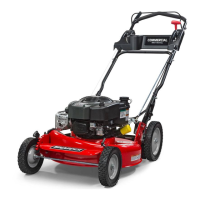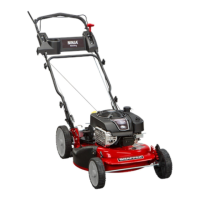Maintenance
(Continued)
WARNING
The
electrolyte
(acid)
produces
a
highly
explosive
gas
all sparks,
f lame
and
f ire away
f rom
area
when charging
battery or
when haldling electrolyte
or battery.
Electrolyte
(acid)
is a highly corrosive
liquid.
Wear
eye
protection.
Wash affected areas
immediately after
having eye or skin
contact
with
electrolyte
(acid).
Battery acid
is
corrosive.
Rinse empty
acid containers
with water and
mutilate
before
discarding.
lf acid is spilled on battery,
bench, or clothing,
etc., Flush
with
clear
water and
neutralize with baking soda
D0 N0T attempt
to charge battery
while installed on
the
rider.
D0 N0T use
"B00ST"
chargers
on the battery.
D0 N0T attempt
to charge
the battery
while
installed
the rider.
D0 N0T use
"B00ST"
chargers
on
the batt
DO
NOT OVERFILLI
A
0n
ery
WARNING
Battery Service
1. Remove the battery.
Refer to the section entitled
"BAT-
TERY REMOVAL".
2. Place the battery
in a wellventilated area
0n a
level
sur-
face.
3. Using
distilled
water, refill the cells as
required
to
cover
the cell
plates
(of
which can also be
viewed through
the
plastic
battery case)
4. With the cell caps
removed, c0nnect
the battery charger
to the battery terminals.
Red to
positive
(+)
terminal
and
black to
negative
(-)
terminal.
5. Slow charge
the battery at
1
amp
for 10 hours.
6. lf
the
battery
will
not
accept
a charge or
is
paftially
charged after
10 hours of charging
at 1 amp,
replace
with
a
new battery.
Battery
Storage
lf the
mower is to be stored out
of season on
its rear
bumper,
it rs recomnlended
the battery be
removed, charged
and stored.
'1.
Remove
the battery.
Refer to the section entitled
"BAT-
TERY REMOVAL"
2. Perform battery service.
3. Bring
the battery to
full
charge,
if required.
4.
Store
the battery
in
an
area away
from the rider on a
wood surface.
D0 NOT STORE
THE BATTERY 0N
A
CONCRETE SURFACE.
New Battery
Preparation
1. Remove
the
battery
from
the
carton.
2. Place the battery
in a wellventilated
area 0n a
level non-
concrete
surface.
3.
Remove
the
battery
cell caps.
Fill the cells as
required
with electrolyte
(purchased
separately)
to the
proper
level. Filling
the
battery
with
electrolyte
will bring
the
battery
to B0% charged
state.
4. With the cell caps
removed, connect
the battery charger
to the battery
terminals;
RED to
positive
(+)
and
BLACK
to negative
(-)
terminal.
IMP0RTANT:
Never
place
anything
in the battery
other
than
the specif
ied electrolyte.
5. Slow
charge
the battery at
1 amp
for 2 hours to bring
the battery
to
full
charge.
6.
After charging,
check
the
level of electrolyte and
add as
needed to bring
the level
to
3/1
6" above
the cell
plates.
7.
Reinstall the cell
caps.
B.
Remove
the hair
pin
and
swivel
f rom the deck support
to allow clearance
for battery
installation.
9.
Slide
the
battery
partially
into the battery
housing
10. Connect
the red
positive
(+)
cable
(8,
Figure
49) f irst,
f rom the wiring
harness to
the
positive
terminal
(+)
on
the
battery,
using
the bolt and
nut
provided
in the
hard-
ware bag. Connect
the black
negative
(-)
cable
(A)
last.
to the negative
terminal
(-)
on
the battery
using the bolt
and
nut. Apply a smallamount
of
grease
over
the termi-
nals to
orevent
corrosion.
11.lnsert
the
battery
completely
into the battery
houstng
12. Reinstall
the battery cover
(A,
Figure 48)
I3.
Reinstall the swivel
and
hair
pin
for
the
deck
support.
Battery
Testing
There are
two types of
battery
tests: Unloaded and
Loaded
The unloaded
test
is the
procedure
that
will be dtscussed
lt's
the simplest and
most commonly
used
An unloaded
test is
made on a battery
without discharging
current
To
perform
unloaded
testing, check
charge condition
using either
a
hyd rometer or
voltmeter.
1. Using a
voltmeter,
voltage readtngs
appear
tnstantly to
show
the state
of charge.
Remember
to hook
the
posi-
tive
lead to the battery's
positive
terminal. and
the nega-
tive
lead to the
negative termtnal.
2.
A hydrometer
measures
the specif
rc
gravity
of each cell
The specific
gravity
tells the degree
of charge:
generally
a
specilic
gravity
of about
1.265
to 1.280
tndicates full
charge.
A reading of
1.230 to
1.260 indicates
the battery
should
be charged.
The chart on
the next
page
shows
the charge
Ievel as
measured by syringe
f loat hydrome-
ter, digital
voltmeter and
five ball
hydrometer
WARNING
Shield
the
positive
terminal
with
the terminal cover
located
on
the battery
harness.
This
prevents
metal
from touchlng
the
posrtive
terminal,
which could
cause sparks
26
www.snapper.c0m

